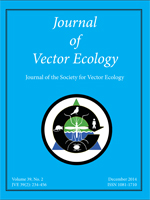Mosquitoes of both sexes feed on plants to obtain sugar. Nocturnal species probably locate the plants primarily by their volatile semiochemicals that also form the basis for the mosquitoes' innate plant-species preferences. To evaluate these olfactory preferences quantitatively, we used a two-choice wind-tunnel olfactometer to measure the upwind orientation of Anopheles gambiae Giles, an important vector of malaria in equatorial Africa, toward odor plumes produced by nine plant species common where this mosquito occurs. These plants are reported to induce feeding behaviors in An. gambiae and to produce floral or extrafloral nectar. Results presented here demonstrated that the volatiles of S. didymobotrya, P. hysterophorus, S. occidentalis, and L. camara, in descending order of numbers of mosquitoes responding, were all attractive, compared to a control plant species, whereas D. stramonium, R. communis, S. bicapsularis, T. stans, and T. diversifolia were not. As expected, chromatographic analysis of the headspace of attractive plants whose volatiles were captured by stir-bar sorptive extraction revealed a wide range of compounds, primarily terpenoids. Once their bioactivity and attractiveness for An. gambiae, alone and in blends, has been firmly established, some of these semiochemicals may have applications in population sampling and control.
How to translate text using browser tools
1 December 2014
Olfactory Basis of Floral Preference of the Malaria Vector Anopheles gambiae (Diptera: Culicidae) Among Common African Plants
Mahmood R. Nikbakhtzadeh,
John W. Terbot,
Philip E. Otienoburu,
Woodbridge A. Foster
ACCESS THE FULL ARTICLE
It is not available for individual sale.
This article is only available to subscribers.
It is not available for individual sale.
It is not available for individual sale.

Journal of Vector Ecology
Vol. 39 • No. 2
December 2014
Vol. 39 • No. 2
December 2014
Anopheles
odor
olfactometry
plant attraction
plant scent
sugar feeding




